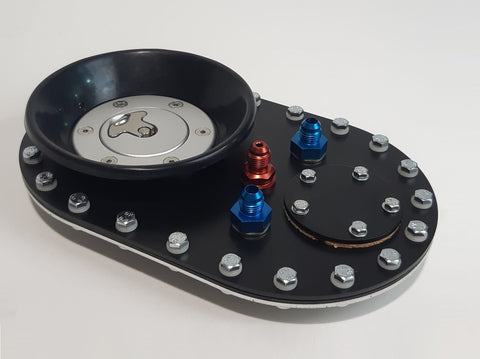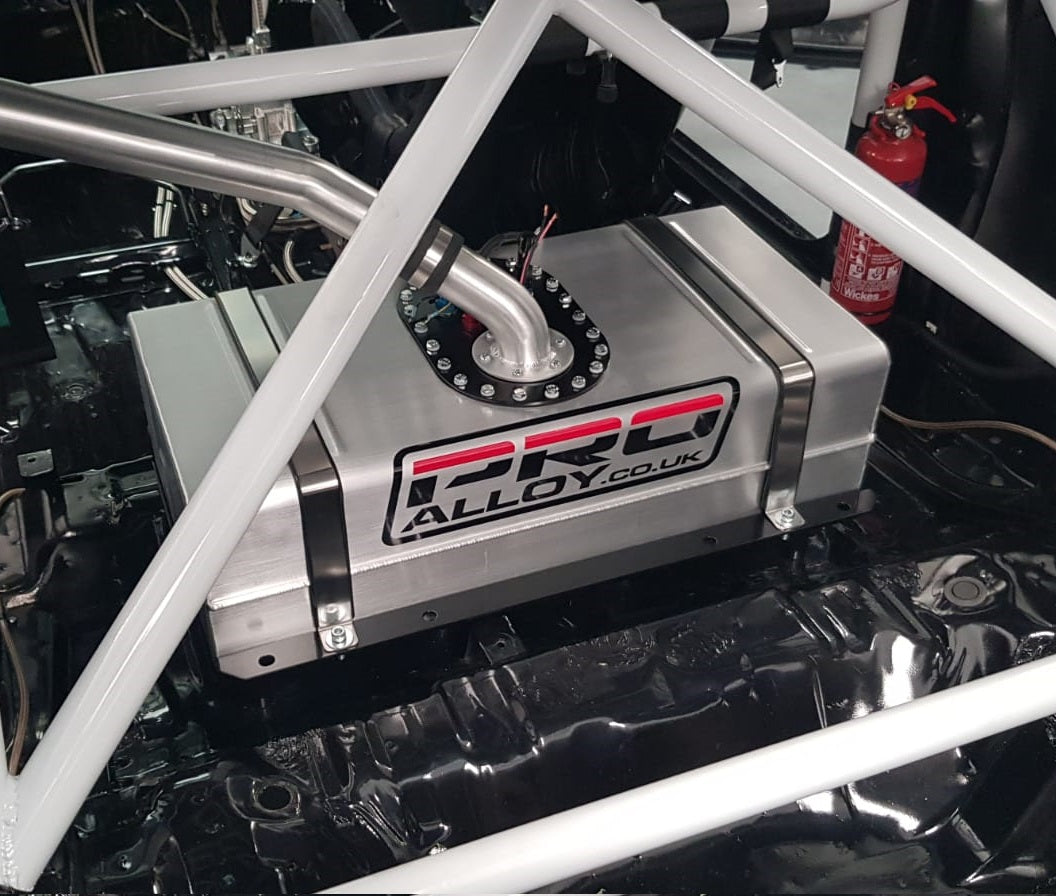There are many aspects of fuel system design which perhaps are not immediately obvious, and most standard road going fuel tanks will show their inherent weaknesses as the demands placed upon them become more stringent. A tuned engine will of course benefit from a fuel pump upgrade, but the physical aspect of fuel delivery is only part of the challenge.
Fuel tanks are usually made as fairly wide, low-slung assemblies as they should be mounted in a position that suits the weight distribution of the car. Mass centralisation and low centre of gravity are factors which have long been proven to provide stable handling characteristics, but unfortunately what you really do not want is a fuel tank with a wide footprint. This encourages violent fuel slosh at each end of the tank, and fuel migration can lead to pickup issues. A long, fast corner at a racetrack is a definite hotspot for such a situation to occur, and under these conditions it is a real problem if the engine starts to run lean due to the pump scavenging for fuel. This is known as cavitation and your steady flow of fuel will rapidly turn to aerated froth. A tuned race engine will not last long under these conditions.
So, an ideal shape for a fuel tank is a tall cylinder with a small diameter footprint. This ensures a stable fuel pickup point with barely any fuel movement left to right during violent cornering. For obvious reasons it is not possible to have a fuel tank like this with any meaningful capacity, so we need to work with the existing shape of the tank but introduce the correct features to ensure fuel stability. Standard tanks fitted by OE manufacturers will not have much in the way of anti-surge equipment, and it’s likely that the standard fuel pump will only tolerate a certain amount of engine tuning before it can no longer supply at the required rate.
Traditionally, custom fuel tanks were baffled using vertical plates to help limit the amount of fuel movement and although this is still viable, there are proven examples which have steered us away from such features. Firstly, there is a concern regarding the weld area of a baffle, especially in an alloy tank. These can be stressed by the weight of fuel crashing into them, bending the plate backwards and forwards which over time can create a stress crack in the welded areas.
To combat this, we created our internal collector system, which uses a series of check valves to allow the fuel to enter the pickup area. Once the fuel has entered the chamber, the mass of the fuel holds the valves closed, so during hard cornering you will have a stable fuel collection point. The collector unit can either feed an outlet for a gravity fed pump, or it can have a fuel pump assembly fitted within. We have a range of electric fuel pumps which can be selected to suit your application, and this is a far neater solution than the old method of external swirl pots etc.
In days gone by, car builders would use a low-pressure pump to deliver fuel to an external swirl pot. From here you would then feed fuel into the secondary pump which would deliver fuel at higher pressure to your carbs or fuel rail.
This does rather over complicate the system, and introduces more component parts, additional plumbing and an extra pump. Coupled with the added expense of all this hardware, you have more opportunity for fuel system leaks or component failure. A self-contained fuel pump fitted inside the tank is a very popular choice nowadays, it is neat and cost-effective, provides the anti-surge feature and cuts down on unnecessary complications.
Our fuel cells are built to comply with MSA regulations for motorsport, which we consider sound practice for a component so intrinsically linked to safety. These aspects form much of the build specifics, and our team will happily help you design the fuel system you need for your application. The golden rule with these assemblies is to discuss them at length, but only build once! It is never practical to modify a used fuel tank, the process of making them safe and reworking an incorrect design is often problematic and it’s usually easier to start again. Our expert advice will ensure you get the correct system designed and executed first time.

This image shows a cutaway view of one of our Pro Tank assemblies, showing the internal anti-surge collector. These incorporate a ball valve system, which ensures that the fuel collection point is always full, whether you are feeding into a remote pump or have an internal pump setup. This system is far more effective and reliable than baffles, and is essential for long, fast corners where fuel will naturally want to migrate away from the pickup area.

The image above shows a four-valve collector chamber with integral Walbro fuel pump. We have many options for such fitments, once we know the fuel delivery requirements of the engine we can choose an appropriate pump to suit. In these setups, you can have the fuel supply and return fittings anywhere you like on the tank, we will install custom internal plumbing as required.

Above is shown a typical access plate setup, featuring Aero filler with spill tray, AN fuel line fittings and MSA approved roll valve / breather. There is also a feature for a VDO level sender unit, this example has a blanking plate fitted, but will allow the addition of a sender later if required.

Here we can see a custom-built fuel cell, together with a mounting tray, classic remote filler and rubber lined, stainless steel strap kit. We always recommend fuel tanks be strapped into position on the vehicle, as welded brackets can be stressed by violent fuel migration. The tank shown here has twin internal fuel pumps, as can be seen by the pair of cable feeds on the access plate. These setups can be complex as internal one-way valves are often required, enabling switching between main and reserve pumps in some applications.
Of course, fuel tanks can be all different sizes and shapes, and feature many types of internal equipment. Most of our fuel tanks are built with approved type IV polyether foam, but this is not always required. The foam is compatible with all usual pump petrol, diesel, avgas and ethanol-based fuels, including E85. There are currently significant changes being made, the jump from E5 unleaded to E10 is causing a fair amount of concern, especially among the classic car community. We will go into more detail about that further down the page.

Here is an example of a much more complex build, a commission from a private owner for his Ferrari 250 swb. This was a no-compromise build, right down to every last rivet head, which were all made and welded in place individually. The final assembly was a faithful reproduction of the original piece, all completely made by hand in our workshop.
This type of build places far more emphasis on the fabrication techniques of the tank, matching every curve and profile to produce the perfect finish. It is a very labour-intensive job, but the nature of such things requires a keen eye for detail, plus a passion for authenticity and level of finish.
Not all fuel cells are quite so involved, some are very simple items but nevertheless we will always ask what the application is so we can best design the tank to suit the requirement. Have a chat with our technical team about your ideas for a fuel system, we can always offer some sound advice to help with your project.
Our “Pro Tank” range is about as close as it gets to a universal fuel tank solution, but as there are so many options for final build specification, we do need to build each one to order. Most options are catered for on our website, but our technical team are always on hand to help with your enquiry. More information can be found about the Pro Tank range here:
https://www.proalloy.co.uk/collections/pro-tank

These tanks are a neat solution and together with the alloy mounting tray can be installed into the rear boot area of many different vehicles. These are MSA compliant assemblies and will be built to suit your requirements, contact our technical team for more information.
Ethanol Based Fuels.
In this section, we will try to deal with some of the more regular questions that arise in connection with ethanol-based fuels and their potential effects on fuel system components. There are common misconceptions that ethanol eats into aluminium, but this is not actually the case. Let’s have a look at what occurs when increased levels of ethanol are introduced to your fuel.
One of the natural properties of aluminium is that it has an oxide layer, which serves to protect the alloy and offer some resistance to material corrosion. Increased levels of ethanol can exacerbate the rate at which the oxide can be broken down, and this mechanism can lead to phase separation. One of the properties of ethanol is that it is hydrophilic – this means that it naturally attracts water. The density of water is 1000kg / m3 at an ambient temp of approx 4 deg C, therefore “1” is the widely accepted specific gravity of water.
This means that water is heavier than fuel, by approx 20% - 25% when compared to petrol, diesel and kerosene. Naturally this means that water will separate and collect at the bottom of your fuel tank, the remaining fuel sitting above it. Phase separation occurs when the constituent parts of the liquid are broken up into ethanol / water & fuel.
Aluminium with a reduced level of protection will be susceptible to corrosion from the water content. If your vehicle is left unused in an environment which may encourage higher levels of condensation, then expect the resulting water to migrate towards the ethanol, then collect at the bottom of the tank.
Some vehicles and equipment are fitted with water drain points, such as aircraft which will have their water traps checked during the pre-flight procedure. As the water will drain out from the bottom of the tank first, it’s a simple process to see, and in fact measure the moisture content of the fuel load. As this is not a regular feature in the automotive world, greater care will be required when it comes to storing your vehicle for extended periods.
We can fit drain plugs to all our fuel tanks during manufacture, and we are being asked to do this more regularly, especially now as even normal pump fuels are being blended with varying amounts of ethanol. The longer-term effects of using these fuels will not be fully measurable until enough time has passed, but the likelihood is that most classic cars will have to run on Super Unleaded fuels for the foreseeable. The ethanol content of E10 has certainly been responsible for rapid deterioration of some older rubber hoses, and this will undoubtedly lead to many owners upgrading their fuel hoses etc.
Our fuel tanks can be built with a variety of threaded fittings, giving customers an opportunity to upgrade their fuel lines from rubber to braided. Speak to one of our technical team about the options available, we’ll be happy to help.








